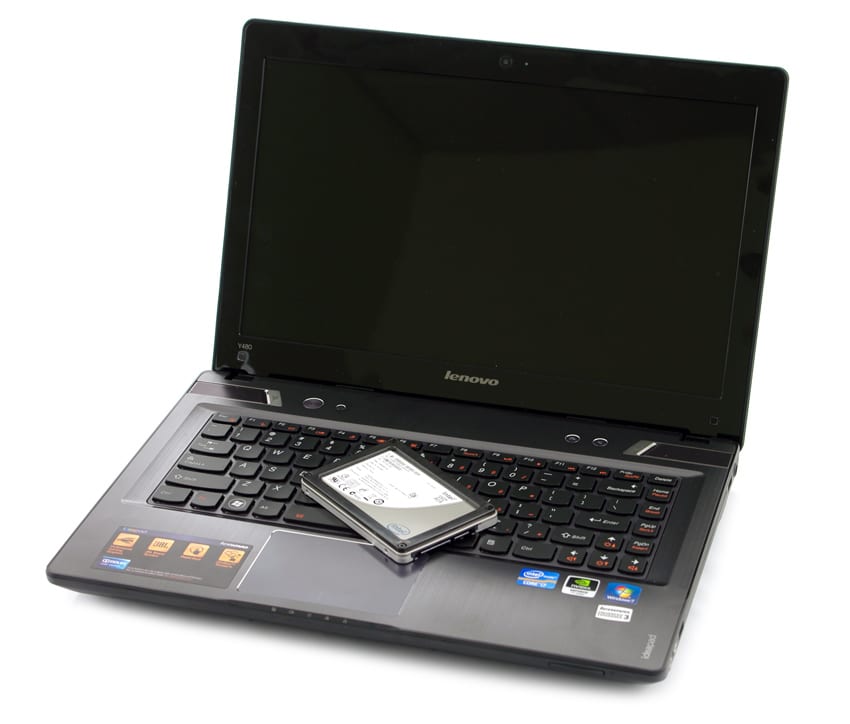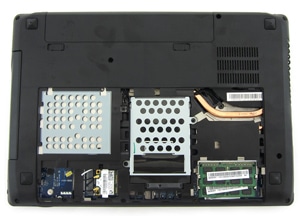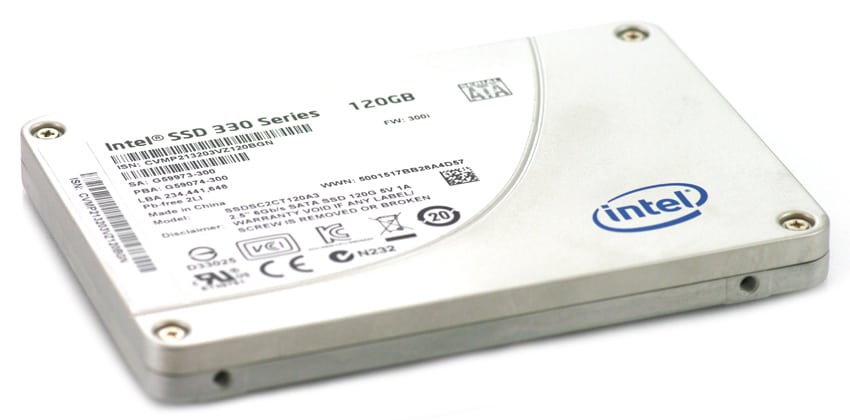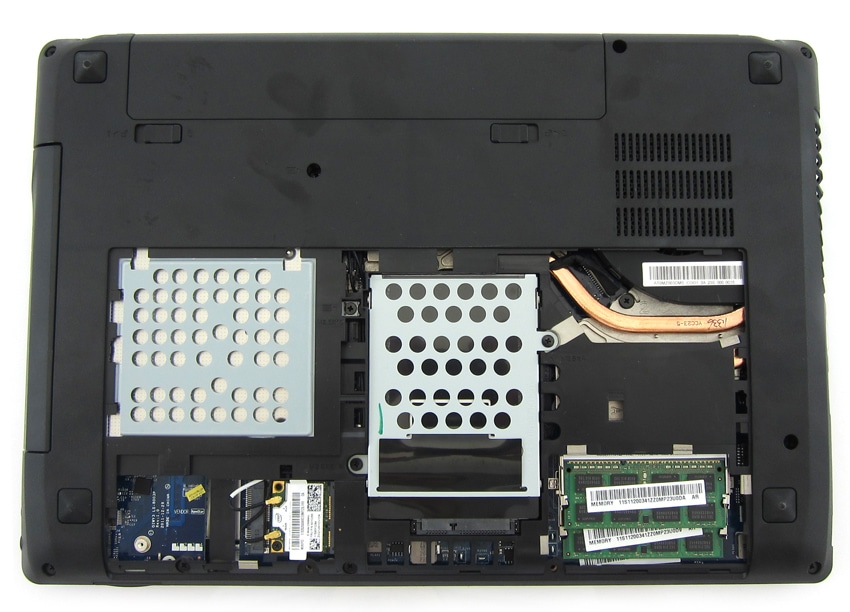
We recently reviewed the new Intel SSD 330 and awarded it an Editor’s Choice for its combination of capable performance and value. The Intel 330 120GB flavor can be had for only $150 at retailers, putting it within reach of many consumer buyers looking to boost the performance of a laptop that might be hobbled by a slow hard drive. It just so happens we have another one of Intel’s latest technologies in house, a laptop equipped with the new Core i7-3610QM “Ivy Bridge” family processor. This Core i7 processor, housed inside the new Lenovo IdeaPad Y480, offers incredible processing performance but the laptop itself is still hobbled with a slow 5400RPM hard drive. Fortunately the Y480 is easy to upgrade, so we took the liberty of stuffing the Intel 330 inside it to see just how much of a performance boost resulted.

Before we go any further, let’s take a look at the performance oriented specs for the 14” screen Lenovo Y480 laptop that we’re targeting to upgrade:
- Processor: Intel Core i7-3610QM 2.3GHz Quad-Core processor (3rd generation, Intel Ivy Bridge)
- Graphics: NVIDIA GeForce GT 640M LE with 1GB of GDDR5 memory
- OS: Windows 7 Home Premium 64-Bit
- Memory: 8GB of DDR3 memory @ 1600MHz
- Storage: 750GB Hard Drive with 5400RPM rotational speed
| We’re going to put this
|
Inside of this |
Everything specs wise is impressive, except for the slow 5400RPM hard drive that is. Granted, the 750GB capacity of storage will appeal to some users, but if your aim is speed then the hard drive will be the Achilles heel that brings you down. The price of this Lenovo Y480 as configured was $999 so the upgrade cost of $150 would only be an additional 15% of spending. To determine whether that’s a worthy investment, let’s first look at a few benchmark scores that were achieved with the stock hard drive configuration.
| Benchmark Program | Lenovo Y480 with Hard Drive Score |
| PCMark 7 Overall Score | 2,229 PCMarks |
| PCMark 7 Storage Score | 1,479 |
| PCMark Vantage Overall Score | 8,634 PCMarks |
| PCMark Vantage Storage Score | 3,537 |
| Windows Experience Index Overall | 6.8 |
| Windows Experience Index Storage | 6.8 |
| Bootup Start time to Desktop (BootRacer) | 82 seconds |
If you’re not familiar with FutureMark’s PCMark suite of benchmark products then those scores might be a little useless out of context. Suffice it to know that the scores are excellent and indicate that the Y480 is capable of running just about any application you can throw at it, including the latest 3D games. The glaring benchmark there is the slow bootup time of 82 seconds. Despite the fact the laptop is crazy fast, it’s slow to bootup, the hard drive is like a huge inertia that has to be overcome before the speed and momentum of the other components can take over.
The process for placing the Intel SSD 330 is very straight forward for the Y480. We simply cloned the hard drive to the Intel SSD 330 using Acronis True Image 2010 and an external USB 2.0 enclosure and then swapped the SSD into the laptop. The Y480 can accept up to 9.5mm size drives, which is the height of the Intel SSD 330, so there were no issues with fit. Thinner Ultrabook style laptops that only have a 7mm clearance for drives wouldn’t be compatible with this particular SSD. The IdeaPad Y480 itself is easy to open up and upgrade, removing a panel on the bottom held down by two screws was all it took to access the storage bay.
If you read the Intel SSD 330 review you’ve already seen all the detailed performance numbers and charts so we won’t rehash those here. Instead we’ll just report the overall benchmark numbers the rejuvenated Lenovo Y480 achieves with its new storage mechanism:
| Benchmark Program | Lenovo Y480 with Intel SSD 330 | Lenovo Y480 with Hard Drive Score | % Score Improvement with Intel SSD 330 |
| PCMark 7 Overall Score | 5,251 PCMarks | 2,229 PCMarks | 135% higher |
| PCMark 7 Storage Score | 5,185 | 1,479 | 250% higher |
| PCMark Vantage Overall Score | 18,170 PCMarks | 8,634 PCMarks | 110% higher |
| PCMark Vantage Storage Score | 47,877 | 3,537 | 1,253% higher |
| Windows Experience Index Overall | 5.9 | 6.8 | 15.25% higher |
| Windows Experience Index Storage | 5.9 | 6.8 | 15.25% higher |
| Bootup to Desktop time (BootRacer) | 11 seconds | 82 seconds | 87% less time |
Score jumps of over 100% in the overall PCMark benchmarks are impressive, the evidence speaks for itself, the $150 spent for this upgrade can literally pay for itself in the time saved over a period of a few months. Heck, all you have to do is reboot your computer a few times over the course of a year and the minute or so saved in watching the laptop boot each time will be add up to hours saved. If your time and patience are worth anything there’s a value proposition right there. And if you just care about applications running faster, you’re in for a treat there too. Opening up a web browser or any other application is noticeably faster, it’s not just milliseconds of performance advantage but real perceived performance boosts the Intel SSD 330 provides to the Lenovo Y480.
Before… |
After! |
It probably doesn’t come as much of a surprise to storage enthusiasts, but the only conclusion we can make here is that the latest processor and graphics technology in the Lenovo Y480 is nice to have, but without an SSD to accompany it it’s only as good as the weakest link, that being the slow 5400RPM hard drive. The new Intel SSD 330 with its budget oriented price yet impressive performance thanks to its SandForce controller and high quality NAND is a good choice for mainstream consumers. For those looking to upgrade or buy a new laptop soon, we definitely recommend hunting for an Intel Ivy Bridge based system and then combining it with an SSD such as the Intel 330, the performance returns are amazing.
Related Articles
About The Author: Andrew Baxter is the Editor of Laptop Reviews where he writes news and reviews covering the laptop industry. He is also a Contributing Editor at StorageReview.com.


